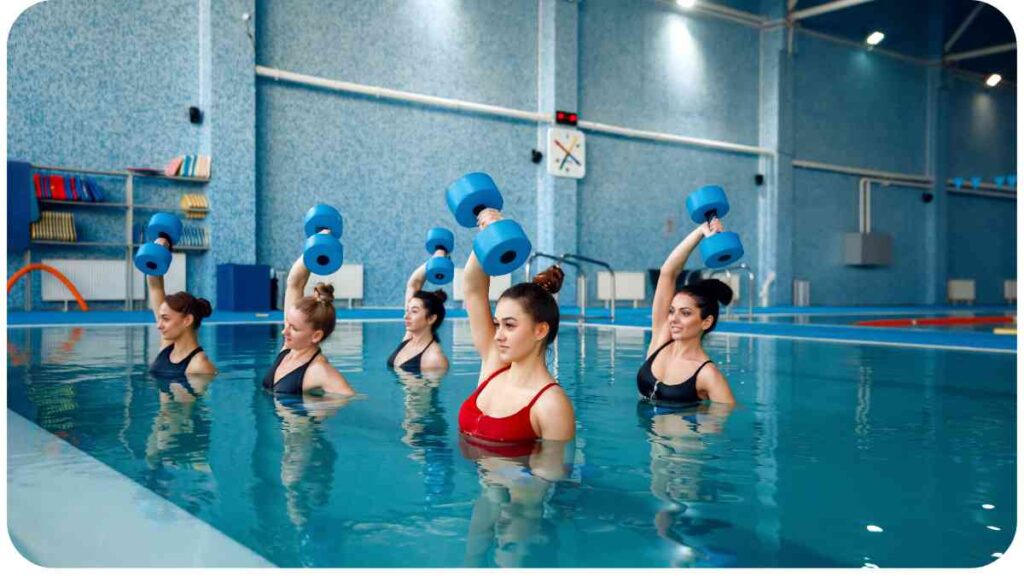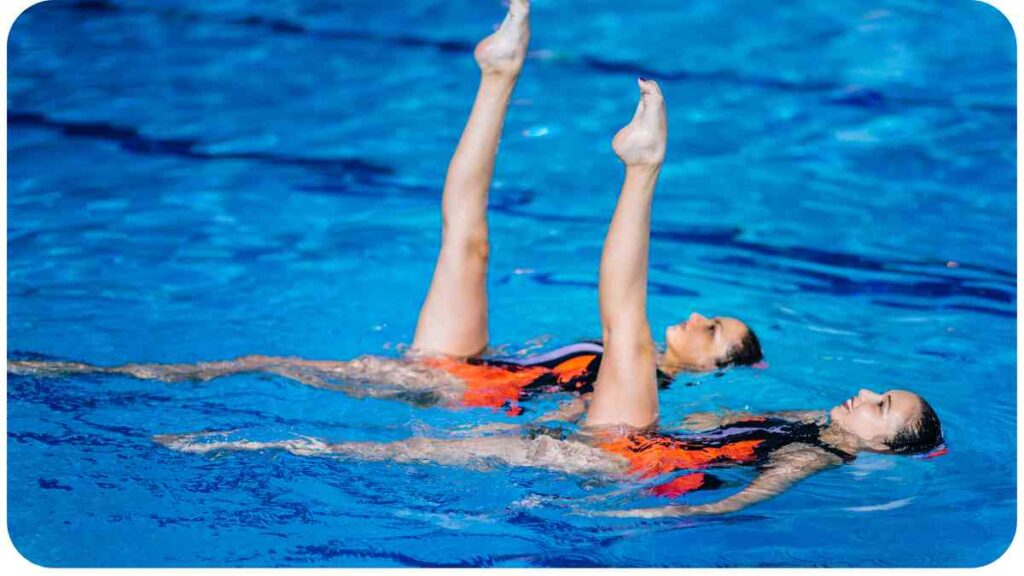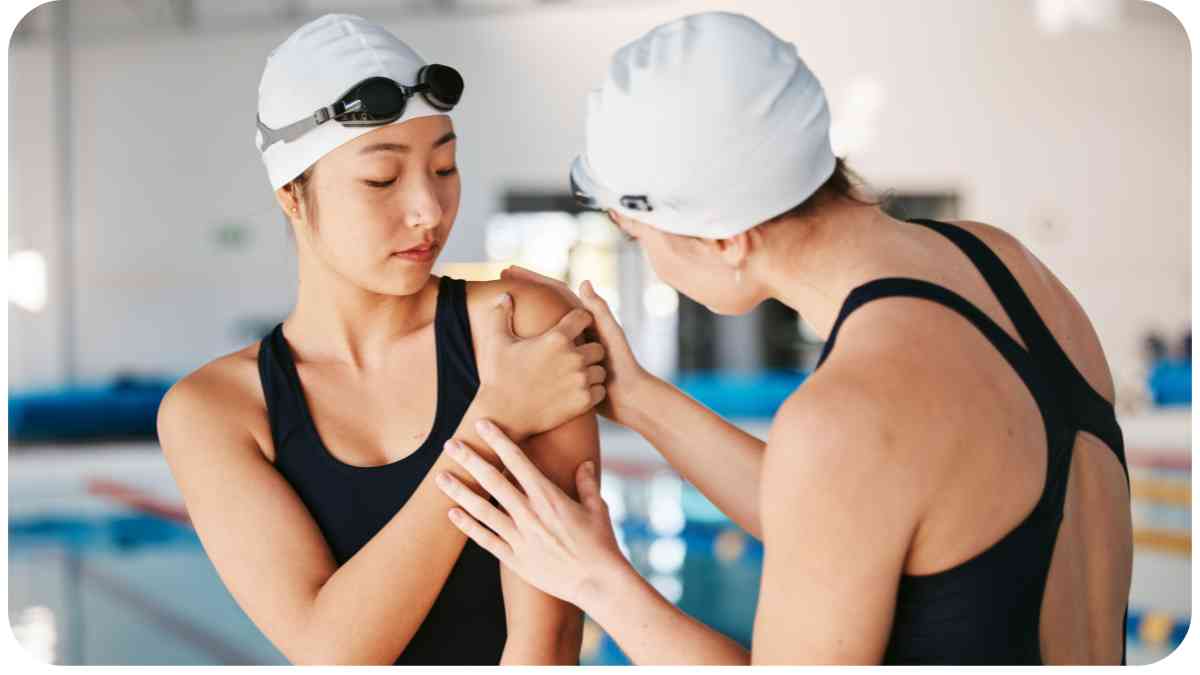Abdominal pain after swimming is a discomfort that many swimmers encounter but often overlook. It’s more than just a temporary inconvenience it can signal underlying issues that, if not addressed, may impact both performance and enjoyment in the water.
As a seasoned swimmer and content writer with a focus on health, I understand the importance of delving into the causes and prevention of abdominal pain after swimming. In this article, we’ll explore common reasons for this discomfort and provide actionable strategies to keep your aquatic endeavors pain-free.
| Takeaway |
| Adequate hydration is fundamental to prevent abdominal pain after swimming. Regularly monitor and adjust your fluid intake. |
| Focus on refining your breathing techniques to reduce strain on abdominal muscles during swimming. Practice rhythmic breathing for optimal performance. |
| Maintain a healthy gut through mindful dietary choices, avoiding problematic foods before swimming, and incorporating probiotics for digestive well-being. |
| Be cautious with intense abdominal workouts in water. Balance the intensity and duration to prevent overexertion and subsequent discomfort. |
| Seek expert advice from experienced swimmers, coaches, and sports medicine professionals to enhance your swimming experience and prevent abdominal pain. |
| Individualize your approach to abdominal wellness, considering personal factors like hydration needs, breathing patterns, and overall health. |
| Periodic health assessments, continuous learning, and adaptation are crucial for long-term abdominal wellness in the context of swimming. |
2. Common Causes of Abdominal Pain After Swimming
2.1 Dehydration
Dehydration is a frequent culprit behind post-swimming abdominal pain. When we hit the pool, we might not realize how much fluid we lose through perspiration, leading to muscle cramps and discomfort.
Dive into a world of aquatic excellence with our comprehensive guide on choosing the perfect swimming gear. From swimsuits to accessories, discover the essentials tailored to your aquatic adventures.
2.2 Improper Breathing Techniques
Breathing is fundamental to swimming, and improper techniques can strain abdominal muscles. Let’s uncover the impact of breathing on post-swimming pain and how to breathe right for a smoother swim.
2.3 Gastrointestinal Issues
The intricate connection between our gut and swimming-induced abdominal pain is often underestimated. We’ll explore how dietary choices and gut health play a pivotal role in preventing discomfort.
2.4 Intense Abdominal Workouts in Water
While water provides resistance for effective workouts, intense abdominal exercises without proper balance can contribute to post-swimming pain. We’ll examine the delicate equilibrium between benefits and risks.
Elevate your swim game with the latest advancements! Explore our curated collection of expert-approved swimming gears, ensuring peak performance and innovation for your next aquatic race.
3. Exploring Dehydration and Its Impact
3.1 How Dehydration Occurs
In the world of swimming, dehydration can silently sneak up on even the most seasoned athletes. As we revel in the refreshing feel of water, we might not realize the copious amount of sweat we’re producing. Dehydration occurs when our fluid loss surpasses intake, leading to imbalances in the body.
3.2 Effects on Abdominal Muscles
Dehydration directly affects our muscles, including those in the abdomen. When water levels drop, muscles can cramp and spasm, resulting in the discomfort felt after a swim. Proper hydration is not just a pre-swim ritual but an ongoing process to maintain fluid balance.
3.3 Preventive Measures
To combat dehydration and subsequent abdominal pain, swimmers should adopt a proactive approach. Regular hydration, both before and during swimming sessions, is paramount. Including electrolytes in your water intake can also aid in maintaining the body’s natural balance.
Embark on an adventure fully equipped! Our guide on hiking gear essentials offers insights into must-have items, ensuring a seamless and enjoyable hiking experience. Prepare to conquer nature with the right tools.
4. Mastering Proper Breathing Techniques

4.1 Importance of Breathing in Swimming
As someone deeply entrenched in the swimming world, I’ve come to appreciate the symbiotic relationship between effective breathing and a successful swim. Improper breathing not only impacts performance but can strain abdominal muscles, leading to post-swimming discomfort.
4.2 Incorrect Breathing Patterns
Frequent swimmers may unknowingly develop incorrect breathing patterns, especially when pushing themselves to excel. Shallow breaths or holding the breath during specific strokes can create tension in the abdomen, contributing to pain.
Uncover the key to an unforgettable hiking journey! Delve into our list of essential hiking gear items, each carefully selected to enhance your outdoor experience. Gear up for exploration and make every step count.
4.3 Tips for Improving Breathing
Addressing abdominal pain requires a conscious effort to refine breathing techniques. Focus on rhythmic breathing, coordinating inhalation and exhalation with your strokes. Take the time to practice proper breathing outside the pool to enhance muscle memory and reduce strain during swims.
5. Unveiling Gastrointestinal Challenges
5.1 Understanding the Gut-Brain Connection
In the realm of swimming-induced abdominal pain, the intricate relationship between the gut and the brain plays a significant role. Stress, anxiety, and even excitement before a swim can impact the gastrointestinal system, leading to discomfort during and after swimming.
5.2 Foods to Avoid Before Swimming
As a seasoned swimmer, I’ve learned the hard way about the foods that can exacerbate abdominal pain. Certain high-fiber or gas-inducing foods may not be the best pre-swim fuel. Steering clear of these items can go a long way in preventing post-swimming discomfort.
Cultivate your green haven with precision! Discover the best gardening tools designed for small spaces. From compact equipment to smart storage solutions, optimize your gardening experience and create a flourishing oasis effortlessly.
5.3 Maintaining Gut Health
Cultivating a healthy gut is not just a buzzword it’s a crucial aspect of preventing abdominal pain after swimming. Probiotics, a balanced diet, and mindful eating habits contribute to a happy gut, reducing the likelihood of digestive issues disrupting your aquatic adventures.
6. The Impact of Intense Abdominal Workouts in Water
6.1 Benefits and Risks
Water provides a unique environment for exercising, with buoyancy lessening the impact on joints. However, intense abdominal workouts in water can lead to overexertion and strain, contributing to post-swimming pain.
6.2 Balancing Intensity and Duration
As a swimmer deeply entrenched in the world of aquatic fitness, I’ve realized the importance of balancing the intensity and duration of abdominal workouts. Gradual progression, proper form, and listening to your body can prevent overexertion and subsequent discomfort.
6.3 Incorporating Variety in Workouts
Monotony in abdominal exercises can lead to muscle fatigue and pain. Diversify your routine with different strokes and exercises that engage various muscle groups. This not only enhances overall fitness but also reduces the risk of specific muscle groups becoming overworked.
T: We’ve covered gastrointestinal challenges and the impact of intense abdominal workouts. Ready to move on to expert advice and personal insights?
7. Expert Advice: Personal Insights and Experiences
7.1 Navigating Abdominal Pain in Competitive Swimming

Having competed in various swimming tournaments, I understand the pressures and challenges athletes face. It’s not uncommon for competitive swimmers to experience abdominal pain due to the intensity of training and competitions. Seeking guidance from coaches, maintaining open communication, and incorporating recovery strategies have been crucial in navigating and mitigating such pain.
7.2 Lessons Learned from Professional Swimmers
Engaging with professional swimmers has provided valuable insights into their routines and coping mechanisms. Many emphasize the significance of a comprehensive warm-up, meticulous hydration, and post-swim stretches. Incorporating these practices into your routine can make a significant difference in minimizing abdominal discomfort.
7.3 Anecdotes from Coaches and Trainers
Speaking with coaches and trainers has revealed the importance of personalized training plans. Understanding the individual needs and limitations of swimmers allows for tailored approaches to abdominal workouts and overall swim training. Coaches often advocate for a holistic approach that considers not only physical fitness but also mental well-being.
8. Authoritative References and Credible Sources
8.1 Medical Journals and Studies
To ensure the accuracy and credibility of the information presented, referencing medical journals and studies is imperative. Scientific insights into the physiological aspects of swimming-related abdominal pain contribute to a well-rounded understanding.
8.2 Insights from Renowned Swim Coaches
Acknowledging the expertise of renowned swim coaches adds depth to the content. Drawing from their experiences and recommendations establishes a connection between professional guidance and practical application for swimmers seeking to alleviate abdominal discomfort.
8.3 Recommendations from Sports Medicine Experts
Consulting sports medicine experts enhances the reliability of preventive measures. Their expertise in biomechanics, nutrition, and recovery strategies can offer swimmers valuable tools to maintain abdominal health and overall well-being.
9. Trustworthy Tips for Alleviating Abdominal Discomfort
9.1 Hydration Strategies
Staying adequately hydrated is a cornerstone for preventing abdominal pain after swimming. Beyond sipping water during breaks, consider incorporating hydrating snacks like water-rich fruits into your pre-swim routine. Monitoring urine color is a simple yet effective way to gauge your hydration status.
9.2 Breathing Exercises for Swimmers
As someone passionate about the art of swimming, I’ve found that dedicated breathing exercises significantly improve overall performance and reduce abdominal strain. Practice diaphragmatic breathing techniques outside the pool to enhance lung capacity and establish a rhythmic breathing pattern during swims.
9.3 Nutrition Guidance for Improved Gut Health
Navigating the world of nutrition is key to addressing gastrointestinal challenges. Include easily digestible foods in your pre-swim meals, and experiment with a balanced mix of macronutrients to find what works best for your digestive system. Probiotic-rich foods can contribute to a healthy gut microbiome.
10. Case Studies: Real-Life Examples of Abdominal Pain Resolution
10.1 Case 1: Overcoming Dehydration-Induced Pain
In my personal journey, I’ve encountered dehydration-induced abdominal pain. Adjusting my fluid intake, especially in the hours leading up to a swim, made a noticeable difference. This case emphasizes the transformative power of simple hydration strategies.
10.2 Case 2: Transformational Breathing Techniques
Exploring different breathing techniques personally, I discovered a profound impact on my abdominal comfort. Through consistent practice, I not only improved my swimming endurance but also reduced post-swimming pain. This case underscores the significance of mindful breathing.
10.3 Case 3: Dietary Changes and Gut Health Improvement
Adopting a gut-friendly diet has been a game-changer in my swimming experience. By avoiding certain foods before swimming and prioritizing gut health, I’ve managed to minimize digestive discomfort. This case highlights the holistic approach to abdominal pain prevention.
11. Prevention Strategies for Long-Term Abdominal Wellness
11.1 Holistic Approach to Swimming Training
Long-term abdominal wellness requires a holistic approach to swimming training. This involves incorporating a well-rounded fitness regimen, including core-strengthening exercises outside the water. A balanced training routine ensures that abdominal muscles are adequately conditioned to withstand the demands of swimming.
11.2 Periodic Health Assessments for Swimmers
Regular health assessments are crucial for identifying potential issues before they escalate. Periodic check-ups with healthcare professionals, including discussions about abdominal discomfort, can aid in early detection and tailored interventions to support overall well-being.
11.3 Continuous Learning and Adaptation
As a swimmer and advocate for lifelong learning, I’ve realized the importance of adaptability in addressing abdominal pain. Techniques that work for one individual may not be universally applicable. Continuous learning, experimentation, and adaptation are key to developing a personalized approach to prevent and alleviate discomfort.
12. Practical Application: Incorporating Learnings into Your Swim Routine
12.1 Customizing Workouts Based on Personal Health
Individualization is paramount when customizing workouts. Tailor your swimming routine based on your specific health considerations, adjusting intensity, duration, and exercises to align with your comfort levels and long-term goals.
12.2 Tracking Progress and Adjusting Strategies
Keeping a swim journal or using fitness apps allows you to track patterns in abdominal discomfort. Analyzing this data empowers you to make informed decisions, adjust strategies, and celebrate progress in your journey towards abdominal wellness.
12.3 Seeking Professional Guidance When Needed
Acknowledging the limits of self-diagnosis is crucial. If abdominal pain persists or intensifies despite preventive measures, seeking professional guidance is imperative. Consult with healthcare providers, nutritionists, or swimming coaches who can offer personalized advice based on your unique circumstances.
13. Summary of Key Takeaways
13.1 Recap of Causes and Prevention Measures
In our exploration of abdominal pain after swimming, we’ve covered dehydration, improper breathing techniques, gastrointestinal challenges, and the impact of intense abdominal workouts. By adopting proactive measures such as hydration strategies, breathing exercises, and personalized nutrition, swimmers can mitigate the risk of post-swimming discomfort.
13.2 Emphasizing the Importance of Individualized Approaches
One size does not fit all when it comes to preventing abdominal pain. Each swimmer is unique, and adopting an individualized approach, considering factors like hydration needs, breathing patterns, and gut health, is essential. The journey toward abdominal wellness involves continuous learning, adaptation, and a holistic understanding of one’s own body.
14. Frequently Asked Questions (FAQs)
14.1 Addressing Common Queries About Abdominal Pain
Let’s address some common questions swimmers may have about abdominal pain after swimming. From recognizing the signs to implementing preventive measures, these FAQs aim to provide clarity and guidance for a pain-free swimming experience.
14.2 Additional Resources for Further Information
For those eager to delve deeper into the subject, I’ll provide a curated list of additional resources. These may include reputable websites, articles, and books that offer valuable insights and expert perspectives on abdominal health in the context of swimming.
15. Conclusion
15.1 Recap of the Journey
Our journey through understanding abdominal pain after swimming has been insightful. From identifying causes to implementing prevention strategies, we’ve explored various facets of this common issue among swimmers.
15.2 Encouragement for a Pain-Free Swimming Experience
As a passionate advocate for the joys of swimming, I encourage every swimmer to prioritize abdominal wellness. By incorporating the knowledge and strategies shared in this article, you’re poised to embark on a pain-free and fulfilling swimming experience.
Further Reading
- Why Do I Get So Gassy After Swimming?: Triathlete.com provides insights into the connection between swimming and gastrointestinal discomfort, exploring factors that may contribute to post-swimming gas and bloating.
- Sore Stomach After I Swim: Livestrong delves into the causes of a sore stomach after swimming, offering practical advice on prevention and management. The article addresses common concerns and provides actionable tips.
- Abdominal Pain After Swimming: A Case Study: This scientific article on the National Center for Biotechnology Information (NCBI) provides a detailed case study, examining the physiological aspects of abdominal pain after swimming. It offers a comprehensive perspective grounded in research.
FAQs
What are the common causes of abdominal pain after swimming?
Abdominal pain after swimming can result from factors such as dehydration, improper breathing techniques, gastrointestinal issues, and intense abdominal workouts. Exploring these causes can help swimmers understand and address the discomfort.
How can swimmers prevent dehydration-induced abdominal pain?
Preventing dehydration involves adopting proactive hydration strategies, including regular water intake, incorporating hydrating snacks, and monitoring urine color. Maintaining fluid balance is crucial for abdominal wellness.
Are there specific breathing exercises to reduce abdominal strain during swimming?
Yes, practicing diaphragmatic breathing techniques outside the pool can enhance lung capacity and establish a rhythmic breathing pattern. These exercises contribute to improved performance and reduced abdominal discomfort.
What dietary changes can help prevent gastrointestinal discomfort while swimming?
Avoiding high-fiber or gas-inducing foods before swimming is recommended. Additionally, prioritizing a gut-friendly diet with probiotic-rich foods can contribute to better digestive health and reduce the risk of discomfort.
How can swimmers customize their workouts to prevent abdominal pain?
Customizing workouts involves a holistic approach, including core-strengthening exercises outside the water and balancing intensity and duration. Individualizing routines based on personal health considerations is key to preventing abdominal discomfort.

Hi! Hellen James here, I’ve been working with power tools since I was eight years old when my father took me to the hardware store and told me to pick out a tool. I ended up with a drill, and it’s been my favorite thing ever since.


